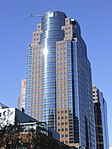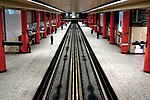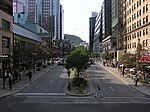1981 McGill College
1982 establishments in QuebecDowntown MontrealEmporis template using building IDModernist architecture in CanadaMontreal stubs ... and 5 more
Office buildings completed in 1982Quebec building and structure stubsSkyscraper office buildings in CanadaSkyscrapers in MontrealWZMH Architects buildings

1981 McGill College, also known as The Richter Tower, is an 82 m (269 ft), 20-storey office complex in Montreal, Quebec, Canada. The building was designed by WZMH Architects. It is located on McGill College Avenue at the intersection of De Maisonneuve Boulevard, in the Ville-Marie borough of Downtown Montreal.1981 McGill College is currently owned and managed by Canadian insurance company Industrial Alliance. It consists of 96,380 square feet of office space.
Excerpt from the Wikipedia article 1981 McGill College (License: CC BY-SA 3.0, Authors, Images).1981 McGill College
Rue Victoria, Montreal Ville-Marie
Geographical coordinates (GPS) Address Nearby Places Show on map
Geographical coordinates (GPS)
| Latitude | Longitude |
|---|---|
| N 45.5034 ° | E -73.5729 ° |
Address
Tour Banque Laurentienne
Rue Victoria
H3A 2A5 Montreal, Ville-Marie
Quebec, Canada
Open on Google Maps









